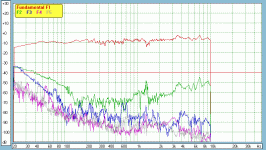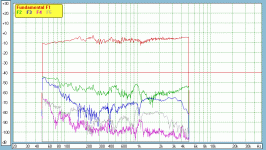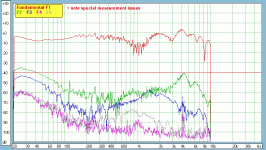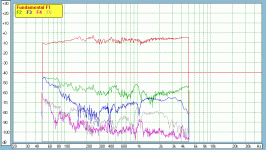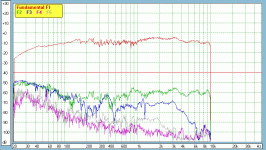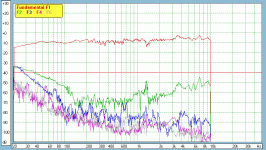Any thoughts on troels' CNO-T25?
It looks well documented, and a cabinet that could be shortened without effecting the volume.
Ian,
At this point I'm not exactly sure what your criteria are for accepting or rejecting a build. So I'm thinking that some objective data might help you, as an engineer, to make a decision.
One of the key measures of a driver's quality is its harmonic distortion measurements. These tell how cleanly a driver is reproducing a tone across the frequency spectrum. It's not the only important measure but it tells you a lot.
Zaph has provided a great asset to the DIY community in addition to his speaker projects by measuring a whole slew of drivers under the same conditions. Head back over to his site and take a look at his measurements for the drivers you have under consideration (look under Current Driver Tests and in his blog). I figure you should be able to get a handle on what they are showing fairly quickly but in particular, you want to be looking at how loud the 3rd harmonic is in the usable frequency range of the driver - the 3rd (and the 5th too) are the dissonant harmonics and thus the most objectionable. Second and 4th harmonics are actually octaves of the original note and so aren't quite so bad.
Below are the HD measurements for the Satori, the Scan 15w8530 and the Seas W18NX. Third harmonic is the blue trace. One driver is significantly better than the others. And as a standard of comparison, you'll also find some measurements for a Kef driver in his Blog section, albeit not the one you have.
Hope that helps.
Attachments
Thanks JReave,
I will go back and re-read Zaph's site with that in mind. Thanks for the pointer.
To be honest, at this point in time I am not remotely sure what my criteria are for accepting or rejecting a build. I am working on the old theory of you get what you pay for, so am wary of the cheap options available.
I will go back and re-read Zaph's site with that in mind. Thanks for the pointer.
To be honest, at this point in time I am not remotely sure what my criteria are for accepting or rejecting a build. I am working on the old theory of you get what you pay for, so am wary of the cheap options available.
Well, you don't have to re-read his whole site.  Just work your way through some of his measurement data. I would think that should be right up your alley.
Just work your way through some of his measurement data. I would think that should be right up your alley.
You should find that although the 'best' drivers will be expensive, the most expensive ones are not necessarily the 'best'. And then there are the ones that are almost as good but only cost anywhere from 1/4 to 1/2 the price. The value leaders. SB Acoustics, Peerless and Dayton RS are some of those. Typically noobies will start out there with their 1st builds and then move on to better drivers on future projects. I accept that to be wise for some people but rejected it for myself and have a very high end set of stand mounts as a result that I am perfectly happy with. For yourself, wishing to only build once, I think that is the way for you to go too.
Also, don't sell yourself short - so far you have been selecting some very good pairs of speakers to look at. I tend to forget about the Seas drivers as I think they may be used more in Europe than over here across the pond. I've never heard them but looking at the measurement data, I suspect your latest choice will be a little bit better than the ZD5's (even though they don't dig quite as deep as the smaller drivers, F3's of about 40Hz and 33Hz respectively) but not as good as the Kairos, but they'll be more expensive than either of those.
You should find that although the 'best' drivers will be expensive, the most expensive ones are not necessarily the 'best'. And then there are the ones that are almost as good but only cost anywhere from 1/4 to 1/2 the price. The value leaders. SB Acoustics, Peerless and Dayton RS are some of those. Typically noobies will start out there with their 1st builds and then move on to better drivers on future projects. I accept that to be wise for some people but rejected it for myself and have a very high end set of stand mounts as a result that I am perfectly happy with. For yourself, wishing to only build once, I think that is the way for you to go too.
Also, don't sell yourself short - so far you have been selecting some very good pairs of speakers to look at. I tend to forget about the Seas drivers as I think they may be used more in Europe than over here across the pond. I've never heard them but looking at the measurement data, I suspect your latest choice will be a little bit better than the ZD5's (even though they don't dig quite as deep as the smaller drivers, F3's of about 40Hz and 33Hz respectively) but not as good as the Kairos, but they'll be more expensive than either of those.
Hi,
Oh dear, its the every design looks good to a newbie syndrome
if you pick / big up one of features as being unique / important.
FWIW in DIY you don't get what you pay for, you get what
you have researched and carefully weighted. DIY is no more
immune to inflated prices than commercial hifi, and there is
no better excuse for overly expensive x/o components than
starting off with overly expensive drivers. Expensive drivers
and components exist not because they are needed, they
are required to define the top end of the low value market.
High value does exist with DIY, and its the way to go.
There is no point going for broke if you have never built
a pair of speakers. Top notch cabinet design is an area
that is simply not for a newbie, nor are designs that
really require high understanding of cabinets, which
sadly is an area often brushed under the carpet.
Just building the Amigas to your requirements
is enough to be getting on with, to get it right.
rgds, sreten.
If the this thread continues to vacillate all over
the place rather than gravitate to some nitty
gritty sensible real details then I will leave it.
Oh dear, its the every design looks good to a newbie syndrome
if you pick / big up one of features as being unique / important.
FWIW in DIY you don't get what you pay for, you get what
you have researched and carefully weighted. DIY is no more
immune to inflated prices than commercial hifi, and there is
no better excuse for overly expensive x/o components than
starting off with overly expensive drivers. Expensive drivers
and components exist not because they are needed, they
are required to define the top end of the low value market.
High value does exist with DIY, and its the way to go.
There is no point going for broke if you have never built
a pair of speakers. Top notch cabinet design is an area
that is simply not for a newbie, nor are designs that
really require high understanding of cabinets, which
sadly is an area often brushed under the carpet.
Just building the Amigas to your requirements
is enough to be getting on with, to get it right.
rgds, sreten.
If the this thread continues to vacillate all over
the place rather than gravitate to some nitty
gritty sensible real details then I will leave it.
Last edited:
Looking at those graphs I am now looking at the 20l sealed ZDTs!
Do you mean the 2 way sealed ZRT? The ZDT is a 3.5 way.
Zaph|Audio - ZRT - Revelator Tower
(Pasting a link to something you reference is helpful
Ok, let's compare HD (Harmonic Distortion) graphs for the 15W and 18W Revelators. From about 150Hz to 500Hz, 3rd order distortion for the 15W (1st graph) is lower than the 18W. From about 600Hz up, the 18W is lower than the 15W (and isn't that weird because you'd expect it to be the other way around). So kind of a bit of a toss up as to which is better overall in terms of distortion.
Compared to the 3rd graph (the Satori again), 3rd order HD in the Satori is lower than both the Revelators from about 100Hz right up to 10,000Hz. I might try to average things out and say that the Satori's 3rd order is about 10dB lower than the 18W in most of the usable bandwidth, which perceptually amounts to that distortion being half as loud as the other one's (10dB is the change in SPL required for a perceptual 1/2 or twice as loud difference). I'll re-state that distortion measurements aren't the only data that means something but it does make a difference. And again, the Satori is now the less expensive driver.
In terms of the tweeter, the Scan 6600 is definitely a superior driver than the Vifa XT25 but at over 5 times the price. I wish there were distortion measurements for the Satori tweeter that's in the Kairos/Adelphos but there aren't, so I have to rely on what someone like Jeff B says about it, which is that it easily competes in the high end of tweeters and is about $50 less than the 6600.
So in this case, I would again say that the ZRT loses out to the Kairos/Adelphos in both quality and price.
Something else to consider.
You need to decide on what kind of bass response you want (or are allowed to implement ). Most musical content goes down to about 40Hz but some goes below that. F3 sealed for the ZRT looks like about 55Hz. Vented in the larger cab is closer to 30Hz which is about the same as the smaller vented boxes of the ZD5 and Satori speakers. You don't necessarily have to have a huge enclosure to get some low bass - it depends on the driver/cab combination. For your purposes, I would say that an F3 of about 30Hz should be one of your design criteria unless you want to go with a sub.
). Most musical content goes down to about 40Hz but some goes below that. F3 sealed for the ZRT looks like about 55Hz. Vented in the larger cab is closer to 30Hz which is about the same as the smaller vented boxes of the ZD5 and Satori speakers. You don't necessarily have to have a huge enclosure to get some low bass - it depends on the driver/cab combination. For your purposes, I would say that an F3 of about 30Hz should be one of your design criteria unless you want to go with a sub.
There are also arguments for sealed vs vented, for better midrange when you don't ask the driver to do both low bass and midrange at the same time and the problem of your current receiver having no bass management to integrate a sub, but I don't want to over complicate things for you too much.
Compared to the 3rd graph (the Satori again), 3rd order HD in the Satori is lower than both the Revelators from about 100Hz right up to 10,000Hz. I might try to average things out and say that the Satori's 3rd order is about 10dB lower than the 18W in most of the usable bandwidth, which perceptually amounts to that distortion being half as loud as the other one's (10dB is the change in SPL required for a perceptual 1/2 or twice as loud difference). I'll re-state that distortion measurements aren't the only data that means something but it does make a difference. And again, the Satori is now the less expensive driver.
In terms of the tweeter, the Scan 6600 is definitely a superior driver than the Vifa XT25 but at over 5 times the price. I wish there were distortion measurements for the Satori tweeter that's in the Kairos/Adelphos but there aren't, so I have to rely on what someone like Jeff B says about it, which is that it easily competes in the high end of tweeters and is about $50 less than the 6600.
So in this case, I would again say that the ZRT loses out to the Kairos/Adelphos in both quality and price.
Something else to consider.
You need to decide on what kind of bass response you want (or are allowed to implement
There are also arguments for sealed vs vented, for better midrange when you don't ask the driver to do both low bass and midrange at the same time and the problem of your current receiver having no bass management to integrate a sub, but I don't want to over complicate things for you too much.
Attachments
- Status
- This old topic is closed. If you want to reopen this topic, contact a moderator using the "Report Post" button.
- Home
- Loudspeakers
- Multi-Way
- First build - considering ZD5.
